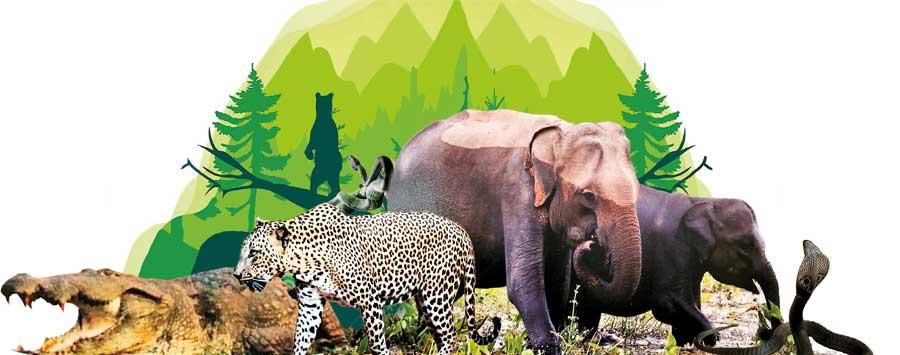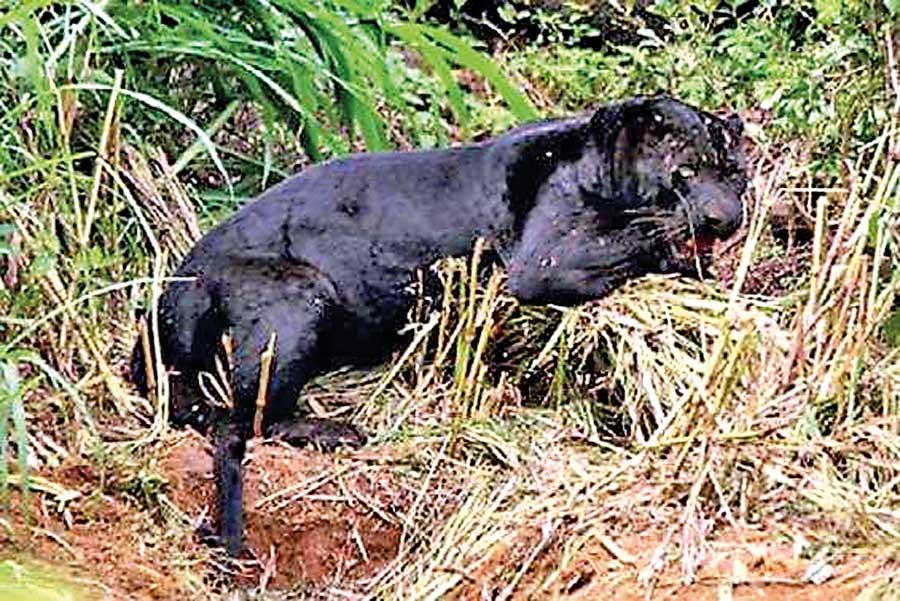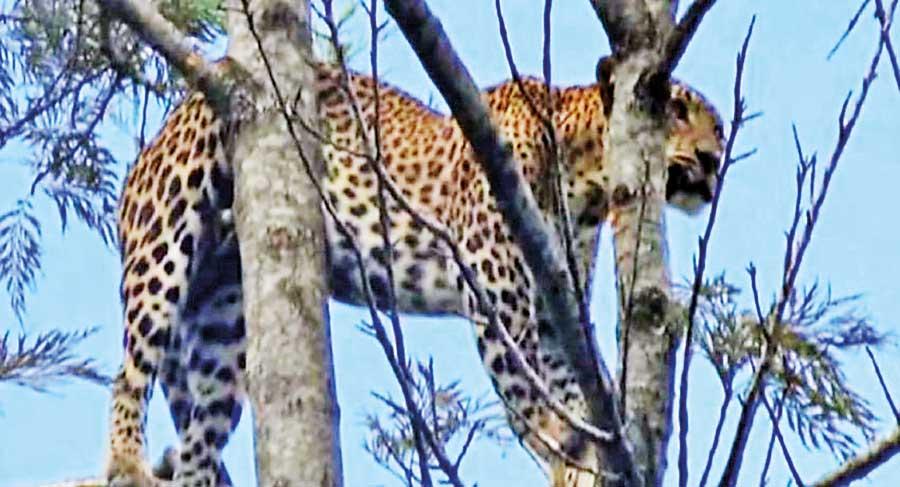15 Feb 2021 - {{hitsCtrl.values.hits}}

For Nalin Hapuhinna, slithery friends were part of his everyday life. Having had a fascination towards snakes from a young age, Hapuhinna was infamously known as ‘Nai Nalin’ back when he was a student at Trinity College, Kandy. Having studied herpetology under the aegis of world-renowned herpetologist Prof. Anslem De Silva at the University of Peradeniya, Hapuhinna has closely studied wild animal research in Australia including the treatment of anti-venom research. He has also followed an alligator conservation course in Florida, USA and has served as a consultant at the Nature Resort based in UAE. Upon observing the gamut of environmental issues at hand, Hapuhinna is ready to put his knowledge and expertise into good use back at home. While awaiting a response to a letter addressed to President Rajapaksa, Hapuhinna shared his views about putting an end to the human-elephant, human-leopard and human-crocodile conflicts and how the processes could be streamlined to serve justice to Sri Lanka’s Wildlife.
Trinity College, Kandy. Having studied herpetology under the aegis of world-renowned herpetologist Prof. Anslem De Silva at the University of Peradeniya, Hapuhinna has closely studied wild animal research in Australia including the treatment of anti-venom research. He has also followed an alligator conservation course in Florida, USA and has served as a consultant at the Nature Resort based in UAE. Upon observing the gamut of environmental issues at hand, Hapuhinna is ready to put his knowledge and expertise into good use back at home. While awaiting a response to a letter addressed to President Rajapaksa, Hapuhinna shared his views about putting an end to the human-elephant, human-leopard and human-crocodile conflicts and how the processes could be streamlined to serve justice to Sri Lanka’s Wildlife.
Excerpts:
- In Australia, if a snake is harmed there is a 60 day penalty and fine
- Gypsies could be used for an anti-venom research programme
- Black leopard could have been saved if proper rescue protocols followed
- We need to do GPS tracking on crocodiles
- The wasps in Sigiriya could be used to mitigate HEC
 Q Why did you choose herpetology over other disciplines related to the study of
Q Why did you choose herpetology over other disciplines related to the study of
|
Nalin Hapuhinna |
animals?
Herpetology wasn’t a dream but I have had a fascination towards snakes since my younger days. A popular myth was that if somebody runs behind snakes, that person was cursed. So I was taken into temples to see what has happened to me. Back in school, I was rarely invited for parties because of my weird hobby. But my friends used to hide their lunch boxes in my bag because nobody dared to touch it as there would always be one or two snakes. Subsequently I earned the nickname ‘Nai Nalin’. After sometime I got permission to continue my hobby in a separate room in school. Back in the day there was a natural society in school syllabuses. We used to organise nature trails to Udawatta Kale and other places. There are 93 species of snakes or rather endangered species. But if you ask someone to name at least five of them, nobody would know.
Q With your knowledge on the field, have you done any research about endemic snakes/reptiles that have a threat of being endangered or extinct in Sri Lanka?
There are mostly misidentified snakes due to lack of knowledge. For people, every snake is a rat snake (Garandiya). Almost every snake is threatened. In Australia, if a snake is harmed there is a 60 day penalty and fine. But here you don’t get such laws.
"I wrote a letter to the President explaining my objectives and what I intend to do and have copied it to several other parties as well. However I’m still awaiting a response"
Q What more should Sri Lanka do in terms of snakes and reptile conservation?
We don’t do anything in terms of conserving snakes and reptiles unlike countries such as Myanmar and Tanzania that have stricter laws. Most of the snakes that come to us have been hurt – either they have been whacked, sprayed kerosene oil and so on. I used to pickup snakes from gypsies because snakes have a threat with them as well. So far we haven’t developed and anti-venom Research programme here. But I believe that gypsies should be kept for this anti-venom research programme. You can find them in down south, Kataragama, Tanamalwila and few other areas. We already have the technology at the Gannoruwa Research Centre.
Q How can we get the younger generation involved in this process?
We need to include wildlife conservation into their syllabuses. When there’s awareness they would identify a snake that comes to their house and determine whether it is poisonous or not. How many snakes would have been killed due to misidentification? Children can also be encouraged to make their own log books, take paper cuttings and find the 93 species. They can go on field trips, guided tours to find habitats, observe endangered species. Then they can repeat it for birds, amphibians and other species as well.

The Black leopard that succumbed to injuries in Nallathanniya as a result of a delayed rescue operation
Q As you know, Sri Lanka is the country that recorded the highest number of elephant deaths during last year. How would you look at mitigating this issue apart from issues such as the human-leopard conflict?
Elephants have an absolute phobia of bees. This could be a good income generator for villagers as well. In Mozambique, they don’t have bees but they put the soundtrack instead. The electric fence doesn’t really work because elephants are smarter animals. You don’t need a 33,000 voltage electric fence to chase away elephants. A tiny shock is enough. We have many solar power companies in Sri Lanka so why can’t we put up fences powered by solar energy. In terms of the human-leopard conflict, again there exist several administrative issues on the part of the Department of Wildlife Conservation (DWC). They take time to get to the venue, they don’t have proper uniforms. The biggest problem is lack of facilities. During the incident of the black leopard, DWC officials took five and a half hours to reach Nallathanniya. But if we could get the DWC to map the areas where leopards have been spotted and report these to the Police station there would be greater protection and awareness among villagers as well. If proper rescue protocols were followed, the black leopard would have lived for another 10 years or so.
"In terms of the human-leopard conflict there exist again several administrative issues on the part of the Department of Wildlife Conservation (DWC). They take time to get to the venue, they don’t have proper uniforms. The biggest problem is lack of facilities"
Q But conservationists believe that the bees you find in Sri Lanka are not aggressive enough....
There are wasps in Sigiriya that have a louder buzz than a normal bee. A little change is all that it takes to mitigate the human-elephant conflict. We need field officers to fulfill these tasks. We are not a massive country like Australia and we can mitigate this issue in six months time.
Q What are the lapses you observe when animals are being rescued?
I have seen DWC officials using their bare hands to treat sick or injured animals. That is not accepted. When cats are tranquilised, they choke themselves with their tongues. They can’t control their mouths when tranquilised. In fact they are brain dead as they don’t get oxygen to their brains. There was one leopard that climbed a tree but subsequently died after being rescued. If the crowd was dispersed and that leopard was allowed to climb down the tree, it would have survived.
"In Australia, they GPS track all crocodiles, measure them and would catch, trap and relocate larger crocodiles into a natural forest"
Q The human-crocodile conflict is another aspect that is not reported and therefore doesn’t receive much attention. With your experience, how could these species be conserved while mitigating the conflict?
We don’t track them. There are two types here. One is Saltwater and mugger crocodiles. 99% of the attacks are by saltwater crocodiles. In Australia, they GPS track all crocodiles, measure them and would catch, trap and relocate larger crocodiles into a natural forest. An overgrown crocodile would attack humans. The biggest one in the area becomes the boldest in the river. What has happened is that we have encroached into their habitats and now we see them as a threat.
Q How would you like to contribute to make a change?
Somewhere around February last year, I was invited by UAE’s Wildlife Conservation Department to assist in conserving the green turtle, Oryx and four types of snakes. I had to report directly to Sheikh Mohammed and give him a report on each species.
Wild animals cannot survive the extreme heat. In terms of turtles there are all male eggs, no females. We were just about to start the programme, but then again I thought whether I should spend the rest of my life here or do something for my country instead. I wrote a letter to the President explaining my objectives and what I intend to do and have copied it to several other parties as well.
However I’m still awaiting a response. But I need to report to the highest authority. We could easily streamline the rescue process, do GPS tracking on crocodiles with experts from Australia, release them into the wild and spread more awareness among people.

Leopard in Maskeliya that succumbed to injuries during the rescue operation
25 Dec 2024 2 hours ago
25 Dec 2024 2 hours ago
25 Dec 2024 3 hours ago
25 Dec 2024 4 hours ago
25 Dec 2024 5 hours ago